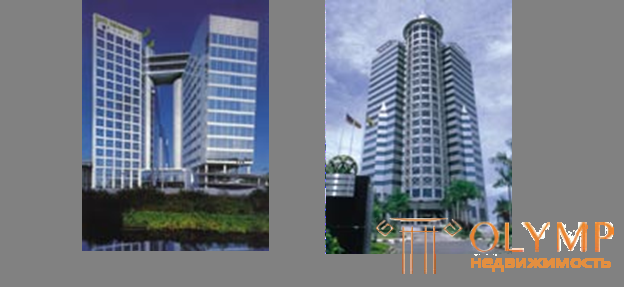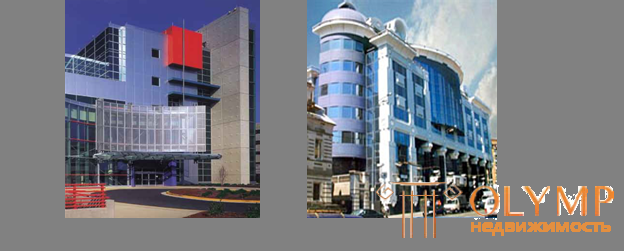
In more detail we will stop on some types of facing wall materials.
Facing sandwich panels . In the systems of ventilated curtain walls, they are facing the outer wall and therefore differ from traditional (enclosing) sandwich panels. The main difference from other types of facings is a combination of decorative and protective properties with heat protection function. Although, if there is a need for this in the calculation, the space between the panel and the wall can be filled with insulating material. Consider facing sandwich panels on the example of products Polyalpan. Polyalpan façade panels consist of an external metal sheet 0.5 mm thick, a layer of polyurethane 25 mm or 50 mm thick for thermal insulation of the facade and a layer of mirror-doped aluminum foil 0.05 mm thick to reflect heat and vapor barrier. The metal sheet for the exterior cladding of the panel is produced by the method of varnished hot drying of an alloy of aluminum, manganese and magnesium with a thickness of 0.5 mm. It may have a surface molded for decorative plaster, wood, etc. The color of the lacquer coating is selected from twenty possible. Chromatization, primer and lacquering of the surface provide resistance to ultraviolet rays and chemical pollutants. Polyalpan panels are not affected by fungus and rot. The material is environmentally friendly, fire resistance refers to the group of non-combustible. The metallic coating of the panels provides absolute moisture protection. The special design of the lateral joint makes water almost impossible to get into the gap between the panel and the wall. Facing Polyalpan sandwich panels are installed on a wooden crate impregnated with flame retardants in buildings up to 5

Fig. 14. 3. - Ventilated facades
Laminated panels. Presented on the Russian market by two types of products. One of them is the construction of heat-resistant laminated plastic. They are made from natural fibers impregnated with synthetic resin-based composition on special laminate presses under pressure and at high temperature. In the production process, the panels acquire: weather resistance, resistance to aggressive environmental influences, high mechanical strength, including bending, impact resistance. They are also frost-resistant, non-toxic, meet the requirements of fire safety. Panel thickness - 6 mm. The company Isovolta (Austria) represents them in the Russian market under the Max Exterior trademark.
Another type of panels is products made of a composite material consisting of a special filler, pressed from both sides with aluminum sheets (0.4 mm) coated with heat-resistant laminate. They have the same properties as the products of the first group. In addition, due to the use of aluminum sheets, the total thickness of the panels can be reduced to 4 mm without loss of strength characteristics. Possess high flexibility. Laminated composite panels are presented under the trademark Duvils-Max - the manufacturer is the company "Duvils" (Russia). Both types of panels can be used for residential, office and industrial buildings, sports facilities, etc. They are used for cladding facades as well as for balconies, parapets, gates, doors and other architectural elements. Products are easily combined with various building and finishing materials: wood, aluminum, glass, metal, creating successful and aesthetic design solutions. This is facilitated by the rich color palette of the panels. The surface has a special UV protection, can be painted in different colors: from pastel tones to fiery red, dark brown, and also in metallic colors.
The panels are easily processed, they can be cut and drilled just like wood and fiberboard panels. Polypropylene panels are represented on the Russian market by the products of the company Nailite (Canada). They are made by injection molding of thermoplastic polypropylene resins, which include special additives that significantly improve the performance properties of the panels. Calcium, thermal stabilizers that protect against UV exposure, etc. are used as additives, which are found both in the resin and in the two layers of coating. Repeated coating with high-quality paint creates additional protection against harmful influences and allows you to maintain an attractive appearance and texture. It should be noted that over time (as a result of the influence of weather conditions) with constant quality, the color of the panel may change. To restore it requires periodic tinting (no earlier than 10-12 years).
Polyurethane and polyester panels. Front panels made of cadmium free polyurethane foam and reinforced polyester recently appeared on the Russian market, but immediately attracted the attention of specialists. Polyurethane panels have a surface with a sprinkling of marble chips in various shades. Natural mineral granulate is added to the polymer during the manufacturing process and is firmly combined with it. The result is a homogeneous structure, with no adhesive compositions are used.
Extrusion panels are produced. In addition to ordinary products, there is a whole system of additional elements for the design of corners, window and door openings, ventilation ducts, etc. Front panels (having 20 mm edges) and all additional parts are designed in such a way that ventilation is maintained. For the lower and upper edges of the facade, special elements are used that allow air to pass through, but prevent dust, dirt, insects, etc., from entering the substructure. The panels can be mounted both on a wooden frame and on a metal frame. Panels are mounted vertically and move towards each other so that the spike gets into the groove. They are attached to the crate through the holes in a special step. For this, screws with a semi-stainless steel head are used. When working with polyurethane siding, covered with natural stone chips, you need to know that the shades of the panels in different batches may differ.
On the object you need to use the panel from only one batch. Materials made of polyurethane foam are represented in Russia by the trademark Dollken (Germany). Under the above brand are also supplied panels, imitating brickwork, reinforced polyester with high resistance to weathering. They differ in durability, have high shockproof and anti-corrosion strength. In this case, not extrusion technology is used, but stamping. A large range of colors and various patterns that imitate stone cladding, brickwork provide architects with ample opportunities for an aesthetic solution of facades.
Panels can be mounted both vertically and horizontally.
Glass cladding. The painted opaque glass used for ventilated facades is manufactured using a special technology. A special water-soluble paint (glass enamel) is applied to the glass, dried, and then this glass is sent to the oven. Paint is injected into the material and becomes part of it. This technology makes it possible to obtain a product not only of various colors (almost the entire spectrum of RAL), but also with heat resistance and the nature of destruction, like in tempered (safe) glass (Fig. 14.4.). Such glass may also have a pattern that imitates natural stone. The coating is applied both to ordinary clear glass and to other base glasses - mirrored, tinted. This is necessary if the architect seeks to solve the entire facade in the same style.

Fig. 14.4. - Example of mounted ventilated facades
Painted opaque glass is produced by the following companies: Saint-Gobain (France) - Emalit trademark, Inprus (Russia) - Stemalit trademark. Granitogres presents another type of glass products for ventilated facades on the market - reinforced glass, primed and painted in any color on the RAL scale.
Что бы оставить комментарий войдите
Комментарии (0)